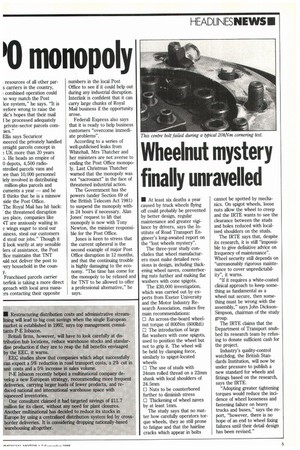Wheelnut mystery finally unravelled
Page 3

If you've noticed an error in this article please click here to report it so we can fix it.
• At least six deaths a year caused by truck wheels flying off could probably be prevented by better design, regular maintenance and greater vigilance by drivers, says the Institute of Road Transport Engineer's long-awaited report on the "lost wheels mystery".
The three-year study concludes that wheel manufacturers must make detailed revisions in design, including thickening wheel naves, counterboring nuts further and making flat washers with cone spigots.
The 230,000 investigation, which was carried out by experts from Exeter University and the Motor Industry Research Association, makes five main recommendations: O An across-the-board wheelnut torque of 800Nm (600Ibft) O The introduction of large flat washers with cone spigots, used to position the wheel but not to grip it. The wheel will be held by clamping force, similarly to spigot-located wheels O The use of studs with 24mm rolled thread on a 22mm shank with local shoulders of 24.5mm O Nuts to be counterbored further to diminish stress CI Thickening of wheel naves by at least lmm.
The study says that no matter how carefully operators torque wheels, they ae still prone to fatigue and that the hairline cracks which appear in bolts cannot be spotted by mechanics. On spigot wheels, loose nuts allow the wheel to creep and the IRTE wants to see the clearance between the studs and holes reduced with localised shoulders on the studs.
The IRTE says that, despite its research, it is still "impossible to give definitive advice on frequency of maintenance". Wheel security still depends on "unreasonably rigorous maintenance to cover unpredictability", it warns.
"If it requires a white-coated clinical approach to keep something as fundamental as a wheel nut secure, then something must be wrong with the assembly," says John DicksonSimpson, chairman of the study group.
The IRTE claims that the Department of Transport snubbed its research team by refusing to donate sufficient cash for the project.
Industry's quality-control watchdog, the British Standards Institution, will now be under pressure to publish a new standard for wheels and fittings based on the research, says the IRTE.
"Adopting greater tightening torques would reduce the incidence of wheel looseness and fastening failure on heavy trucks and buses," says the report, "however, there is no hope of an end to wheel fixing failures until their detail design has been revised."
















































